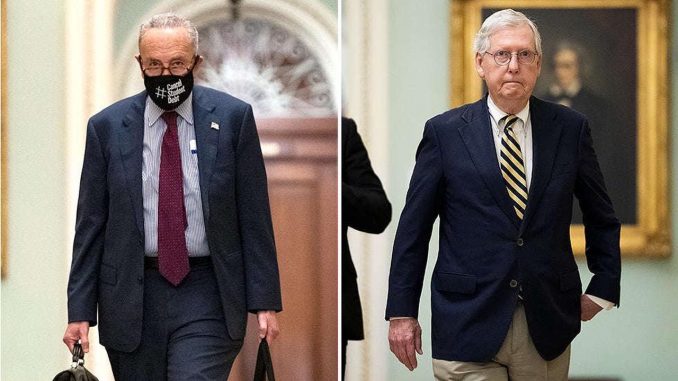
Congress is barreling toward a high-stakes showdown over the nation’s borrowing limit, with neither party ready to blink.
Congressional leaders will soon need to find a way to pass legislation raising or suspending the debt ceiling, or risk a default that could have catastrophic ramifications for global financial markets.
So far, they appear content to play a game of chicken reminiscent of the 2011 standoff that resulted in the S&P taking the historic step of downgrading the U.S. credit rating.
One option for Democrats would be to try to raise the debt ceiling on their own as part of a $3.5 trillion spending package they will try to pass this year under budget rules that let them avoid the need for any GOP votes. Instead, they appear to be betting that Republicans will ultimately put up the votes to help raise the spending limit.
The budget resolution unveiled by Senate Democrats on Monday that sets up the $3.5 trillion spending plan doesn’t mention the debt ceiling. It’s also not included in two summaries, including a memo to Democratic senators that explains what they’ll include in the $3.5 trillion bill they want to pass this fall.
Republicans are vowing they won’t help raise the debt ceiling, even though GOP lawmakers supported suspending it during the Trump administration, amid frustration over Democrats’ plan to bypass them and pass the $3.5 trillion bill.
“Democrats have all the existing tools they need to raise the debt limit on a partisan basis. If they want 50 lockstep Democratic votes to spend trillions and trillions more, they can find 50 Democratic votes to finance it,” Senate Minority Leader Mitch McConnell (R-Ky.) said from the Senate floor.
“If they don’t want Republicans’ input, they don’t need our help,” he added.
The hard line on the debt ceiling comes as Republicans have returned to their Obama-era deficit hawk leanings after brushing off the debt under four years of big spending by former President Trump.
Senate Republicans agreed to put nonbinding language in their caucus rules earlier this year to support requiring spending cuts or reforms in exchange for raising the debt ceiling. And they appear eager to try to make Democrats own spending and the debt heading into 2022 and amid concerns about inflation.
Sen. Lindsey Graham (R-S.C.) had been expected to outline his demands on spending reforms in return for GOP votes on raising the debt ceiling, predicting that Democrats wouldn’t try to do it on their own because it would be a “great ad” for Republicans. But Graham subsequently canceled his plans, saying he supported McConnell’s effort to make Democrats try to address the issue on their own.
Sen. Rob Portman (R-Ohio) told CNBC’s “Squawk Box” that Democrats should be able to raise the debt ceiling “with their own votes,” particularly after they passed a $1.9 trillion coronavirus relief bill without any GOP votes and are now planning to do the same with their $3.5 trillion spending plan.
“So I think that’s something … that they can do on their own and they should, because they’re the ones that have pushed this debt to the point where it really is getting dangerously high,” he said.
When exactly Congress needs to act remains unclear. The spending limit kicked back in on Aug. 1, after Congress and the Trump administration agreed to suspend it in 2019, and the Treasury Department has since been using “extraordinary measures” to keep the government solvent.
The Bipartisan Policy Center estimates the so-called X date, or the point at which the U.S. government will be unable to fully meet its financial obligations on time, will arrive at some point this fall.
The House is out of Washington until late September and the Senate is poised to leave this week, returning in mid-September. That could put the debt fight front and center when lawmakers return next month.
The Treasury Department hasn’t put a firm timeline on how long it expects that it will be able to use extraordinary measures to delay running up against the country’s borrowing limit. But Treasury Secretary Janet Yellen warned in a statement that failing to raise the debt ceiling would cause “irreparable harm to the U.S. economy and the livelihoods of all Americans.”
“Congress should do so again now by increasing or suspending the debt limit on a bipartisan basis. The vast majority of the debt subject to the debt limit was accrued prior to the Administration taking office. This is a shared responsibility,” she said.
To raise or suspend the debt ceiling outside of the budget process, Democrats will need at least 10 Republican votes in the Senate to defeat a 60-vote legislative filibuster. Democrats could try to attach it to another must-pass bill, like a short-term spending bill they are expected to use to fund the government beyond Sept. 30, in order to try to pressure Republicans.
They appear likely to bet that Republicans won’t risk a global financial meltdown so soon after the coronavirus shook the U.S. economy. But Democrats, so far, aren’t laying out how they plan to avoid a financial fiasco if they don’t raise the borrowing limit on their own.
“I don’t know the answer to that,” said Sen. Dick Durbin (Ill.), the No. 2 Democratic senator, told reporters when asked how they would raise the debt ceiling.
Senate Budget Committee Chairman Bernie Sanders (I-Vt.) on Monday was carrying a paper with previous quotes from McConnell about not allowing the country to default.
“Just coincidentally, these are all the quotes of Mitch McConnell, who has said we will never have America default,” Sanders told reporters. “He’s right.”
Via The Hill


